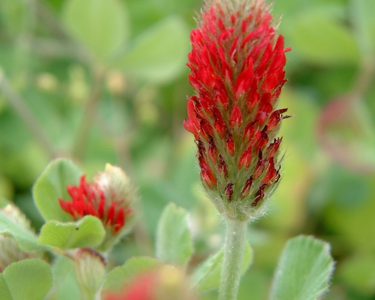Taking cover - the value of green manures

Green manures - or cover crops - are used by organic gardeners and farmers for a range of purposes. The main one is to improve the soil but they also provide other benefits and ecosystem services such as nutrient management, improving soil structure and organic matter content, weed suppression, nitrogen fixation and provision of resources for biodiversity.
A recent review of the benefits of cover crops on soil quality (1) concluded that they enhance soil organic matter, organic carbon sequestration, physical, chemical, and biological properties, and nutrient cycling.
The review showed that cover crops reduce water erosion by “providing protective cover to the soil, absorbing raindrop energy, reducing soil aggregate detachment, increasing soil surface roughness, delaying runoff initiation, intercepting runoff, reducing runoff velocity, increasing the opportunity time for water infiltration, and promoting the formation of water-stable aggregates”. (2)
Nitrogen fixing cover crops
Cover crops are, of course, used to build fertility and in particular nitrogen. Hairy vetch and crimson clover showed good results (4) as will other legumes. Grasses and other non-legumes do not fix nitrogen, but they can quickly assimilate soil nitrogen as they grow and then release it when incorporated into your soil (5).
The benefits vary with different cover crops. Suggested cover crops were rye and oats (6), winter triticale, lentil and pea (2) red clover (6) and alfalfa (7). Cover crops have been shown to improve water quality, soil fertility, crop productivity and decrease water pollution by reducing water erosion (8). The increased cover and soil organic carbon can also protect from wind erosion (3).
It's thought early season weed control is best done by cover crop grasses as they establish earlier in the season (9). Although an experiment in Turkey using oats, hairy vetch, common vetch and ryegrass suppressed weeds by 28 per cent, 73 per cent, 56 per cent and 70 per cent, respectively (10). Some grasses, such as rye, oats and sorghum can also be effective at suppressing weeds by releasing chemicals from their roots that inhibit other plants' growth - this is called allelopathy (11).
Feeding the insects
Cover crops can also be a good source of nectar and can add to the biodiversity needed to feed the insects in our garden. Studies by have shown that a mix of floriferous plant species in your cover crop mix can support and enhance pollinators in our gardens – as long as they are allowed to flower and not cut and incorporated before this (12).
If you want to take a deep dive into cover crops, have a look at the AgroDiversity Toolbox (13). This is a website that has been developed over a decade or more of research by hundreds of researchers. It has an extensive 'wiki' of subsidiary crops (another name for cover crops), lots of trial data and tools that enable you to design your own green manure.
We're running a Winter Green Manures trial to test a diverse cover crop mix that's suitable for over-winter use in a garden setting. Sign up until 30th July here.
References
3. Bilbro JD (1991) Cover crops for wind erosion control in semiarid regions. In: Cover crops for clean water. Proceedings of an International Conference West Tennessee Experiment Station, Jackson, TN. April. pp 9–11
6. Kleinman PJA, Salon P, Sharpley AN, Saporito LS (2005) Effect of cover crops established at time of corn planting on phosphorus runoff from soils before and after dairy manure application. J Soil Water Conserv 60:311
12. O’Brien C, Arathi HS (2021) If You Build It, They Will Come-Agroecosystem-Based Management Practices Support Pollinators. Ann Entomol Soc Am 114:322–328.
13. AgroDiversity Toolbox contributors (2021) AgroDiversity Toolkit. In: AgroDiversity Toolbox.